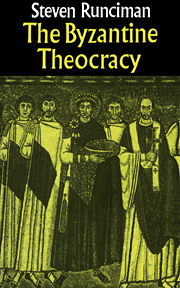Book contents
- Frontmatter
- Contents
- Foreword
- Introduction
- 1 The Christian Empire: The image of God upon earth
- 2 The Viceroy of God: The plenitude of Imperial power
- 3 The battle over images: The challenge of popular belief
- 4 The working compromise: The limits of Imperial control
- 5 The monks and the people: The opposition to the palace and the hierarchy
- 6 Decline and fall: The end of the Kingdom of God on earth
- Notes
- Index
5 - The monks and the people: The opposition to the palace and the hierarchy
- Frontmatter
- Contents
- Foreword
- Introduction
- 1 The Christian Empire: The image of God upon earth
- 2 The Viceroy of God: The plenitude of Imperial power
- 3 The battle over images: The challenge of popular belief
- 4 The working compromise: The limits of Imperial control
- 5 The monks and the people: The opposition to the palace and the hierarchy
- 6 Decline and fall: The end of the Kingdom of God on earth
- Notes
- Index
Summary
In the course of Byzantine history we meet from time to time a politico-religious party based on the monasteries. Even in the fifth century monastic communities such as that of Sosthenion in Constantinople exercised an influence on public affairs. But it was by their leadership in the struggle against Iconoclasm that the monks came to form a cohesive party which thenceforward was a powerful element in Byzantine life. At times this party found support in the Imperial Court. At times the Patriarch might be chosen from amongst its ranks. But for most of the time it was in opposition not only to any Imperial control of the Church but also to the upper hierarchy, which it considered to be over–worldly. Its strength lay in its close touch with public opinion.
It was characteristic of the Byzantines that, while they deeply respected the Imperium and the Patriarchate as institutions, they were far more deeply influenced in their ideas and their outlook by the monks and holy men who moved amongst them. The Emperor from the very nature of his position was required to be a somewhat remote figure. The Viceroy of God had to know his place, which was an exalted one. The Emperor should indeed be gracious and affable when he appeared in public. He should be generous and benevolent and should give kindly attention to suppliants who appealed to his justice or to his charity. He should be humble before God. But the idea, so popular nowadays, that the ruler should be chatty and informal with the man in the street was repugnant to the Byzantine sense of propriety and religion.
- Type
- Chapter
- Information
- The Byzantine TheocracyThe Weil Lectures, Cincinatti, pp. 110 - 134Publisher: Cambridge University PressPrint publication year: 1977



